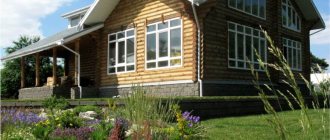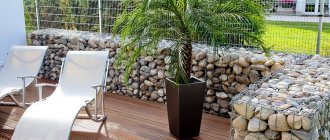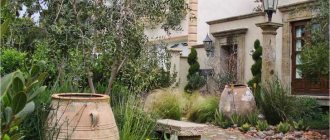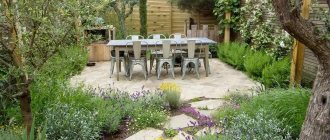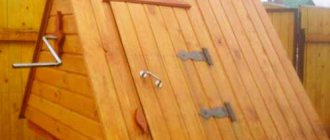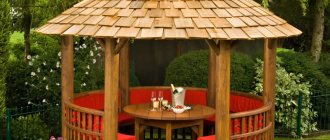Types of ornamental grasses
The diverse family of ornamental grasses allows you to create multi-level and multi-colored compositions. They are not whimsical, grow quickly, and are not capricious when combined with other types of plants. Their seasonal transformations from a grass carpet to original inflorescences, and then to snow-covered waves delight the eye throughout the year.
The picturesque compositions in the photo, consisting entirely of ornamental grasses, make us re-evaluate this type of plant for creative experiments.
Rockeries are a derivative of the rocky plain, a memory of mountain meadows. Stones play a very important role in the creation and design of a rock garden, both large boulders, pointed piles, and crushed stone filling of medium and small fractions. Plants for rockeries should be dwarf, low-growing, slow-growing, creeping and climbing. An indispensable attribute of any rock garden are dwarf conifers and junipers.
Watch the video: Ornamental cereals in the garden and country house
Here their role is not limited to filling empty spaces and framing spectacular colors; they come to the fore, striking with their original natural energy and riot of colors.
The names of many ornamental grasses refer to their appearance.
Evergreen trees
These include coniferous plants - decorative spruce, pine, dwarf cedar, etc. They may not bloom, but they will delight you all year with their pine scent and green branches.
Pine and spruce trees are suitable for large areas; dwarf or slow-growing trees are suitable for tiny areas.
Yew is an excellent tree for small areas. Features – slow growth, feels comfortable in the shade. The plant is quite heat-loving and susceptible to death due to high soil moisture.
Mountain pine is a low tree that does not require special attention to care. Feels great even on poor lands not enriched with useful substances.
- Indoor ventilation
Choosing grass for the lawn
Deutzia is blooming - summer is coming
Hemlock is a tree with an original (umbrella-shaped) crown shape. By trimming old, diseased umbrellas, you can keep them neat and attractive. It grows best in areas protected from wind.
Blue fescue
Blue fescue is a frost-resistant grass. The original bluish color of this cereal in combination with needle-shaped leaves creates an irresistible airy effect.
It looks good on borders and in flower and stone arrangements, but it needs sun to look beautiful.
Silver flower garden style
In nature and in cultivated plantings you can often find plants with silver-gray leaves. In our country, these are thickets of willow or coltsfoot, sea buckthorn gardens, in warm climates - olive and cypress groves, lavender fields, rosemary plantings, sedum and milkweed, as well as “gray-haired” tub plants.
It is generally accepted that silver-blue compositions are intended, first of all, to create gardens in the Mediterranean style - silver, cheerful and cool. But silver is also suitable in gardens of other styles. In regular compositions, symmetrical plantings of blue spruce trees or trimmed hedges in gray tones are sometimes used. Silver-blue colors are absolutely irreplaceable if your garden is decorated in Art Nouveau, avant-garde, neoclassical and neo-Renaissance styles. Landscape style also fully allows for the presence of silver in landscape compositions.
When creating a flower garden in a “marine” style, the obligatory symbolic presence of water is implied, which is depicted with the help of silver, light blue, indigo, white, and gray shades of leaves and flowers. Mixborders of coniferous and decorative-leaved trees and shrubs often include plants with silver-colored leaves and needles.
Flower beds of annuals in any style, especially carpet flower beds, where the pattern is clearly defined, cannot do without these cool tones. Mixborders of perennials, which use a wide variety of plant forms with bright colors, often include silver-gray shades to balance the composition. They serve as a buffer between poorly combined colors, fill it with light, form poles of calm, and make other colors richer and richer. Rock gardens and rockeries often contain silver tones.
The colors white, gray and silver are close in perception - they are neutral and closer to the cold range, but they always attract attention. Gray color is ambiguous; it has unique properties: it fills the garden with light and visually expands the boundaries of the garden or mixborder, which is especially important in small gardens. It softens cold colors (blue, indigo) and combines light colors (pink, cream, white, lilac, apricot), and red, yellow, orange, purple tones begin to literally shine in the presence of gray, showing their expressive character.
Like white, silver has many shades depending on the environment: it can be yellowish and greenish, pinkish and bluish, “gray-haired” and almost white. Depending on the lighting, weather and texture of the leaves, it can be sparkling and dull, matte and metallic, cold and warm, modest and elegant, neutral and noble, magical and mysterious. This play of colors will never seem boring or monotonous! In a silver garden or flower garden, various and correctly selected accessories are extremely important: in the form of gray-blue balls, silver moths, benches, supports and obelisks for climbing plants, galvanized, tin and tin containers, garden sculptures.
Feather grass fluffy cloud
Feather grass fluffy cloud is a steppe unpretentious plant that, when growing, turns into original silky bushes; during flowering, the tips of the bush become pink or golden.
Another unusually beautiful variety of cultivated feather grass, “the most beautiful,” has the thinnest stems covered with transparent fluff.
Start small
The first and, perhaps, the most important technique that is used when creating flower beds without flowering plants is, of course, a game of contrast. Combinations of leaves of different sizes, textures, shapes and colors allow you to create real landscape paintings. However, not every novice gardener can achieve the desired effect using all these characteristics. Lack of experience can play a cruel joke on a beginner, so at first it is better to focus on using one or two techniques.
Mace Bearer
The dense, seemingly bristling bushes of the gray macebearer are ideal for decorating borders 20-30 cm high. This light-loving and fast-growing ground cover plant takes root well in sandy soils of the middle zone.
- Indoor ventilation
- Choosing grass for the lawn
- Deutzia is blooming - summer is coming
How to grow perennial plants for your garden
Not only vegetables and fruit trees can grow in your garden plot, but also evergreens and beautiful flowers, which are planted in a variety of flower beds and flower beds. To carry out this work, gardeners can use the catalog of perennial flowers and plants for their summer cottage. Colorful photographs with names will help them choose from a wide variety of what is needed for the garden. And in this article, perennial plants for giving photos with names will be proposed. Here you will see their catalog.
Content
Perennial plants. Features of their use in garden plots
Perennials are a type of flowering plant. These include decorative deciduous species. They all have a long growth period. Those. these plants can grow in a flower garden for many years. In addition, there will be no need to replant flowers or additional sowing.
Important! A huge number of perennial plants can perfectly tolerate low temperatures. At this time, green plants will not lose their decorative characteristics.
A large number of perennials are undemanding in terms of growth conditions and care. They begin to bloom earlier than annual plant species.
Area where perennials are used:
- Volumetric compositions;
- Hanging panel;
- Multi-tiered landscape objects;
- Sculptures made of flowers to decorate the garden plot.
It is quite possible to make beautiful flower arrangements from perennial plants. All those plants that belong to this category can be used to create flower beds, acting as the main background for other plants, or as a decorative addition. They differ from each other in height, shape, and color. These differences make them great complements to each other.
Why you need to choose perennials
Many gardeners prefer this type of plant to annuals for a large number of reasons. And now we will list the advantages of perennials:
- The opportunity to design a beautiful flower garden that will retain its visual appeal throughout the entire summer season.
- Landscape design created using these plants can last for many years. This period will depend on the grade of the flower garden. In addition, the summer resident will not need to dig up flowers, replant them, and sow the flower garden all year round.
- A huge number of varieties are resistant to low temperatures. For this reason, the flower garden will survive wintering well in the ground, without the need for additional protective agents. In the warm season, perennial plants will be the first to bloom, since they have a strong root system.
- Growing decorative flower beds will be accompanied by minimal financial costs. In order to preserve the beauty of flower beds, there is no need to buy planting material. A combination of all kinds of garden plants will decorate your garden.
Advice! Use perennials to obtain additional seeds, seedlings, tubers.
Most gardeners like to practice a system of exchanging planting material among themselves. Use this method to receive new varieties for your flower garden for free.
Catalog of perennials for a summer cottage: photographs with the names of the most popular plants
Perennial plants in the garden and country house can make a landscaped area more pleasant. You should familiarize yourself with the proposed catalog. The perennial flowers for a summer cottage with names listed in the catalog can be considered as a guide to the world of landscape design and gardening. Since there is a lot of seed material on the flower market, you should pay attention to the most popular varieties that even a novice amateur gardener can grow.
Important! Watering is the main component of caring for garden plants. Therefore, this important rule must be remembered.
Alyssum: photo, planting and flowerbed care
Alyssum is best suited for dry areas. It can withstand both drought and severe frosts. This plant can take root in almost any soil. There is no need for complex care. Area of use:
- Rock gardens.
- Landscape objects.
- Curbs.
- Flower arrangements that need ground cover addition.
Alyssum has beautiful rich colors and very fragrant flowers. It is planted on top of light fertile soil. This plant needs a lot of sunlight. Alyssum is best combined with paved slab fences, rocky crevices and paths. It should be watered moderately and highly nourished in the first stages of development. Alyssum is an unpretentious plant that can take root even on dry soil.
Anemones: planting, care, flower photos
This type of plant belongs to the genus Anemone. Photos of anemone flowers show off beautiful blues, purples, and bright reds. In harsh areas, this type of plant is grown as annual flowers. The total diameter of its flowers is approximately 65-80mm.
Advice! In order to create a beautiful bouquet from this plant, we recommend cutting off the buds of anemones that have not fully opened and have a weak color. The vase must be filled with water to a quarter of the entire length of the peduncle. Anemone petals should not be wetted.
Planting anemones and further caring for them is very simple. The tubers of this plant must be planted in fertile soil in a place well lit by the sun to a depth of 5 cm. The soil must be breathable. In poor and infertile soil, this plant needs to be fed regularly. It is best to use complex fertilizers for this, which need to be applied to the soil twice a summer. Beautiful rich anemone flowers can decorate any flower garden.
Pansies: planting and care, photo
Pansies are one of the most popular plant species. Their second name is viola. This perennial is characterized by a large number of colors:
- Yellow.
- Snow-white.
- Black.
- Blue.
- With red spots.
Moist loamy soil and a sunny location are optimal for growing this plant. All these factors can increase the time of its flowering. It is best to avoid planting viola in lowlands, where water often stagnates. These flowers must be regularly fed with various fertilizers. For example, superphosphate and ammonium nitrate. But you should not add fresh manure to the soil. In order to extend the flowering period of the plant, i.e. areas that have already bloomed, as well as seed pods, need to be removed. Otherwise, the ripening of seeds will take a large amount of energy from the viola.
Astilbe: planting in open soil and caring for the plant
In this article we list unpretentious perennial plants for the garden. Therefore, you should pay attention to this list.
Many gardeners will probably be attracted to photographs of beautiful astilbe. Planting and further care of this plant may differ, since this flower contains several varieties. They can be short, dwarf, medium, or tall. This perennial has inflorescences resembling panicles of different colors. Planting and caring for astilbe contains the following requirements:
- Soil rich in humus.
- Penumbra.
- Removing flower stalks after flowering.
- Regular watering.
- Does not like overheating of the root system.
Advice! The bare roots of the plant must be covered with a special covering material, or spruce branches must be used for protective purposes, so that the astilbe does not die from low temperature.
This plant does well in a sunny place and also in partial shade.
Asters: planting and care in open ground
In the photographs, aster flowers look very beautiful and impressive. And this is not surprising. This perennial plant is the dominant one that can grow in the garden in the fall. Aster blooms very profusely, almost until the first frost. The shades of aster flowers are distinguished by their diversity: white, light purple, deep pink, delicate lilac.
Basic requirements for planting and care:
- Abundant watering.
- Planting in light partial shade or in a sunny area.
- Feeding the plant with mineral or organic fertilizers.
- Planting in light and permeable soil.
- Divide the plant bushes and plant them once every five years.
The area of application of this plant is most common for decorating the edges of paths and flower beds. Aster plays the role of borders and carpet flower bed.
Bergenia: planting in open soil and caring for perennials
Do you want to know how to grow perennial plants for your garden, then this article was created especially for you. Pay attention to the following plant. Bergenia leaves have a round shape and a shiny surface. The flowers of this plant are pink. Bergenia can develop quite well in fertile soil. It is best to plant this plant in partial shade. And the lack of sun will affect the timing of flowering and the beauty of bergenia. Poor soil can also become the basis for the growth of this perennial.
Application area:
- Flower beds of group type.
- Borders and ridges.
- Rocky areas of the garden.
Please pay attention! The plant that can survive the cold winter will become very vulnerable to the effects of various fungi. Based on this, with the onset of spring, it is necessary to start fertilizing the bergenia and treat the foliage part of this plant with various protective preparations.
Periwinkle: planting in open ground and care
A perennial such as periwinkle belongs to the creeping and climbing species of ground cover plants. It can grow in width very quickly. Vinca leaves are glossy and have a leathery texture. They can be light or dark green. Sometimes you can find leaves covered with spots of cream or golden shades. Periwinkle begins to form a root system quite quickly. Loves partial shade. The soil in this case may be different. But there is only one condition for good development: the soil does not dry out. This perennial can be watered regularly. Periwinkle needs to be trimmed from time to time. During the cold winter months, it is necessary to protect the plant with covering material. Good neighbors for periwinkle will be: primroses, scillas, heucheras, hyacinths.
Colchicum: photographs and features of perennial
Colchicum is very similar to crocus. This plant also has a second name - colchicum. It is quite easy to distinguish the colchicum from the crocus. You need to turn your attention to the flowers. They will be much larger and smell very nice. Just one bulb can form up to four flowers. Periwinkle blooms for 3-4 weeks. Pollinated flowers immediately begin to fade. But this plant can easily overwinter under a layer of snow. As for soil and care, this perennial is unpretentious. The same applies to the conditions of its growth. We recommend planting periwinkle on alpine hills. In addition, ordinary flower beds may also be suitable.
Buzulnik: photos and specifics
The rather large leaves of buzulnik and its original color attract the attention of many gardeners. This plant is mainly characterized by long and abundant flowering. Perennial, easy to care for.
Helpful advice! A sunny area must be chosen very carefully, since too much light will damage and burn the buzulnik leaves. It is best to plant buzulnik in moist and fertile soil.
This plant should be watered as needed. Mineral and organic fertilizers must be applied in late spring. With the onset of autumn, it is necessary to mulch with peat and remove plants down to the root base. It should not be covered with protective material for the winter period.
Loosestrife: photo, planting and caring for the plant
Many gardeners call loosestrife lysimachia. This perennial plant has an erect appearance or creeping shoots. Beautiful photographs of loosestrife can show how beautiful and impressive a flowerbed in a garden plot with red or yellow flowers looks. Some flowers are used as medicinal remedies. A huge number of plants of this species prefer a lot of sunlight. And only some varieties will feel much better in partial shade.
Basic care requirements:
- Abundant regular watering.
- Wet soil.
- Feed the plant with mineral fertilizers 2 times a month.
- Loosestrife can easily withstand cold winters. It does not need to be covered with material.
Gazania: planting, care, photo
Gazania is a plant that begins to bloom with the onset of summer. It has a wide palette of colors. Based on this, many landscape designers nicknamed this plant South African chamomile.
You should pay attention! The perennial gazania includes about 40 varieties that grow in warm countries. A number of them may grow in cold regions. But already as an annual.
Gazania can be grown:
- in the rock garden,
- in flowerpots,
- on a balcony or loggia in boxes,
The plant can also grow as a border plant.
To ensure normal growth and development of this plant, it is necessary to choose open and well-lit areas. The soil must contain turf and sand. Stagnation of moisture in the soil is undesirable. Even during dry periods, this perennial needs to be watered moderately.
Hyacinths: planting in open soil and caring for the plant
Caring for and planting hyacinths, as a rule, comes down to applying fertilizers. In order to get full and large flowers, dry fertilizer is applied to the soil immediately after the first shoots appear and the soil is loosened. It is necessary to re-apply fertilizer to the soil after the formation of buds. In this case, fertilizer should be applied at the root of the plant in liquid form. The third feeding must be done after the hyacinths bloom. This type of plant requires special watering conditions. Before the hyacinth bulbs harden, it is not recommended to allow the soil to dry out. The soil should be moist. In the remaining time, after the sprouts appear, it is necessary to carry out regular watering, especially during the dry period.
Perennial gypsophila: planting, care, photo
Gypsophila looks like a flowering shrub. Beautiful delicate pink and white flowers completely cover this perennial plant and resemble an airy haze. Photos of gypsophila, which you can easily find on the Internet, can clearly show you that this type of perennial will look great:
- At the walls for retaining purposes.
- In the distant areas of the garden.
- In the rock garden.
Gypsophila tolerates low temperatures. The main preferences are light soil with high levels of humidity and fertility, a lighted area.
We recommend! Gypsophila reacts very strongly to transplantation. In order to increase the percentage of positive outcomes, it is necessary to pre-treat the root system with a root formation stimulator.
Gladioli in open ground: planting and care, growth features
Beautiful gladiolus is planted in open areas. In this case, you need to provide protection from the wind. We do not recommend planting this plant in places where water may stagnate. In areas with high heat and dryness, gladiolus will need some shade. Midday sun rays can have a detrimental effect on this plant. For this reason, flowers will need to be protected from direct rays and high temperatures. In areas with a temperate climate, even a slight shade can delay the flowering of gladiolus and reduce the level of decorativeness. Gladiolus will respond well to sandy loam soil, which must be treated in advance to a depth of 25-30 cm and impregnated with organic fertilizers.
Gentian: photo, planting and care, features
In this publication you can also see fast-growing perennial garden plants. Continue to explore our catalogue.
Gentian is a perennial that blooms with bright blue bells. Its flowering period occurs in the summer. This mountain plant is best planted on alpine hills. The group of plants belonging to this genus includes about 400 varieties and varieties. Gentian, like all low-growing flowers, needs a correct and careful approach to the choice of fertilizers. Feeding with a large amount of nitrogen can negatively affect the plant. Exposure to direct sunlight must be regulated. But this does not mean that this perennial should be planted in the shade. Dried gentian shoots must be removed from the flower garden.
Delphinium: photos and varieties
Seeds must be planted in the ground in early March. According to the recommendations of landscape designers, it is necessary to sow densely in order for the flower garden to be lush. After sowing, the flowerbed should be sprinkled with a small layer of earth about 0.3 -0.5 cm thick. The category of perennial plants includes the following types of dolphinarium:
- Large-flowered.
- Holostalk.
- Persian.
- Hybrid.
This plant prefers regular watering. Especially in hot and dry weather. Wet soil must be loosened after watering. But this must be done very carefully.
We recommend! Dolphinarium prefers root watering. A competent watering system will completely help eliminate the appearance of powdery mildew on the plant. .
Di)
In photographs of such a perennial as dicentra, you can see inflorescences in the form of arcs, which are densely dotted with heart-shaped flowers. They come in pink, white and light purple. As a rule, this type of plant has around 10 cultivated varieties. One of the most important conditions for excellent cultivation of dicentra is a well-chosen planting area. This perennial will do best in partial shade. But a sunny place can also be an excellent place for growth for dicentra. The soil must be saturated with organic and mineral fertilizers.
Creeping tenacious: photos and care features
Summer residents prefer to grow tenacious for its good resistance to the negative effects of weather. This plant is not vulnerable to various diseases and pests. Thanks to the fact that the tenacious blooms profusely. Even under conditions of minimal sun exposure, this perennial can be planted in specific places in the garden.
Scope of its use:
- Circular design of tree trunks.
- Decoration of rocky slopes.
- Planting plants at the bottom of a green hedge.
The process of planting, seating and replanting is quite possible to carry out throughout the entire dacha period. Loose soils mixed with turf, peat and sand are suitable for survival.
Honeysuckle: photographs, varieties, description
Honeysuckle is a small fruit-bearing shrub. The plant has many varieties. But if we consider only those varieties that produce edible berries, the choice will be between honeysuckle:
- Kamchatskaya.
- Edible.
- Turchaninova.
- Altai.
This shrub is unpretentious in its care. It can be planted in almost any area of the garden plot. The most important thing is protection from the wind and plenty of sun.
Useful recommendation! Honeysuckle does not like to grow alone. But it also cannot tolerate proximity to similar varieties. In any of these cases, the yield of this plant will decrease sharply.
Clematis: planting and care. Photograph of a vine plant
A perennial such as clematis will be a wonderful decoration for any summer cottage or garden in a private home. Advantages of clematis:
- long flowering period,
- resistance to winter conditions,
- durability,
- ease of care.
Clematis is a heat-loving plant and loves the sun. It is planted in increments of two meters. Unsuitable places for planting clematis are low-lying areas and areas that are located near groundwater. The soil should be sandy and loamy. In very heavy soil, a drainage system will need to be installed. In winter, this perennial must be protected.
Swimsuit: photos and landing features
To plant the swimsuit, you will need to first prepare the soil. For the best development of this plant, shade should be provided. In sunny areas, the swimsuit can also develop well, but a large amount of sunlight can cause the flowers to quickly fade.
Soil requirements:
- humidity,
- looseness,
- presence of drainage.
You should not plant the swimsuit on dry or sandy soil. The plant must be watered regularly, loosened the soil and weeded. Fertilizing the soil is also a necessary procedure. The most suitable nutrition for a swimsuit is the addition of Agricola, nitrophoska and urea in combination: one tbsp. a spoonful of each listed fertilizer and 10 liters of water.
Kupena: photo of a perennial plant
Kupena is a little-known perennial plant. It belongs to the Liliaceae family. On the curved stems of this plant there are bluish-green leaves with droplets of bells hanging down. Lightly shaded areas provide excellent habitat for this beautiful perennial. The sun will only slow down its growth and negatively affect the decorative effect of the plant.
Pay attention! This perennial contains many medicinal properties. It speeds up the metabolism in the body and strengthens the immune system.
Lakonos: photo, description and conditions for its cultivation
Powderwort is a very large perennial plant. The homeland of the lacconaceous plant is America. Over the entire summer period of its growth, this perennial grows from small seeds into a beautiful and lush plant. The height of the Lakonos can reach one meter. By the beginning of autumn, the flower stalks of the plant are completely covered with black shiny berries. Both the berries and the juice of the milkweed are very poisonous. But this fact did not become an obstacle for gardeners. They place it in the center of their compositions. In the very middle of the flowerbed, this plant will not pose any danger. It can be an addition to the hedge, since open sunny areas are harmful to it.
Lilies of the valley: photos and care tips
Before the start of the summer season, all gardeners carefully study the catalogs of perennial plants for spring 2021. Our article is a storehouse of information. Therefore, it is also recommended to study it carefully. Let's talk about lilies of the valley.
The best growing area for lilies of the valley, of course, is moist soil, which is hidden under the shade of spreading trees. This perennial plant can easily tolerate a long absence of sun. But if the shadow is too deep, the number of flowers will decrease. In return for this decrease, the lily of the valley begins to grow foliage
Useful recommendation! Many gardeners advise planting lilies of the valley near fences and walls. Very hot weather will be detrimental to lily of the valley.
Don't forget about watering these plants. It is better to completely avoid transplanting lilies of the valley.
Daylilies: planting and caring for bushes
The shrubs of this plant are planted in a planting hole. For daylilies, the depth of such a planting hole should be approximately 22-25 cm. And the plants themselves are placed in increments of 0.5-0.6 m. Before planting the bush in a hole, you need to pour a small amount of soil in the form of a slide onto the bottom. In the future, roots will spread along it. The part where the transition from roots to leaves begins is called the neck. It goes deep into the soil approximately 3-4cm. Daylilies should be watered abundantly and the soil should be mulched regularly. We advise you to cover the soil around the daylily from 5 to 7 cm around its circumference. After planting, the plant must be fertilized and watered regularly.
Lupines in open ground: planting and care
The decorative value of this plant is quite high. Many gardeners love this plant for the natural beauty of lupins. Caring for and planting perennials is a pleasure. The soil requirements of this plant are low. If you want to achieve optimal conditions for growing lupines, then you need to choose acidic types of soil. In this environment, the flower will begin to improve the composition of the soil and will itself form nitrogen-containing fertilizer on the tubers. In order to increase acidity, we recommend adding manure and sawdust to the soil.
Lungworts: photographs of flowers in the garden plot and features of flower garden care
Landscape designers call lungwort pulmonaria. It differs from other perennials in having beautiful flowers with an early bloom time. With the help of this plant you can beautifully decorate your garden plot:
- Rabatki near garden paths.
- Living borders.
- Ground cover addition to flower beds.
You can plant lungwort in a cool, dark place. Then she will delight you with beautiful flowers even on poor soil. Sandy soil composition is best. This plant loves regular watering. And before winter, it will be necessary to do mulching.
Euphorbia: photo, rules of care and cultivation
To plant milkweed in your garden plot, you need to choose a sunny area. It is also possible to grow spurge in partial shade, but in this case, it will not bloom so profusely.
Important! Heavy soil will be a poor basis for planting milkweed. This will cause the plant to slow down its growth. And in winter, its root system will rot.
The plant should be watered moderately. At the time of its vegetative development, no more than 2 fertilizing with mineral fertilizers can be carried out. And the decorative appearance of this perennial can be preserved by timely removal of dead flowers and pruning.
Muscari: photo on the plot
This type of perennial plant belongs to the Hyacinth family. It would be difficult to find a more interesting plant for a flower garden in a garden plot. Muscari is unpretentious. Muscari got its name due to its musk-like smell. Many gardeners use muscari:
- Armenian (blue, with white border),
- racemose (purple),
- Turgenevsky (light blue),
- grape-shaped (blue, white, blue-violet).
This perennial prefers regular and abundant watering and plenty of sunlight. Muscarine also does well in partial shade.
Narcissus: planting and care in open ground
Daffodils growing next to tulips will be a wonderful addition to the garden plot. Narcissus blooms quite early. It has many different varieties:
- tubular,
- onkeleform,
- terry,
- small-crowned,
- taceniformes,
- cyclamenoides,
- poetic,
- large-crowned.
Planting daffodils is quite simple. The most important thing in this process is to guess the timing. As a rule, the packaging indicates the appropriate month for planting the daffodil. The main conditions for care: regular watering and loosening of the soil, planting other varieties of narcissus and removing diseased plants.
Forget-me-nots: photos and features of perennials
If you want to see what brunera is like, look at a plant like forget-me-not. This plant begins to bloom in late spring with beautiful soft blue flowers. After flowering, they will be replaced by heart-shaped leaves. These leaves have a sharp end.
It is important to know! Forget-me-not needs moisture. If watering is poor, the perennial leaves will begin to wither. For this reason, it is necessary to constantly monitor the timing of watering.
Forget-me-nots are best planted in clay soil, which constantly retains moisture.
Nivyanyk: photos and features
Nivyanik is called differently: roman herb, white chamomile, white flower, popovnik. This plant is a frequent inhabitant of suburban gardens. Nivyanik can perfectly tolerate negative weather conditions (frost, heat). It is necessary to remove faded baskets in a timely manner. This will help the plant prolong its flowering time. If we take into account the origin of this perennial plant, it becomes clear that the cornflower prefers sunny, open areas. It is better to avoid places where water stagnates.
Liverwort: photo and characteristics
Liverwort is also called coppice. This perennial belongs to the genus of the Buttercup family. Its homeland is forests located in northern latitudes, with a predominant temperate climate. In garden plots you can see only one species of this plant - the noble liverwort. The liverwort is famous for its long life span. With proper care, its life expectancy can be 25 years.
Peonies in the ground: planting and caring for a flower bed
Peonies can be seen in many gardens and parks. This plant loves light and fertile soil. In one place he can live up to 45-50 years. To plant peonies, you need to choose areas that are sunny but protected from strong gusts of wind. Peony bushes love to grow. For this reason, when designing paths, you need to leave a small space between the planting hole and the path. There is no need to plant peonies under the walls of buildings. All the rainwater falling from the roof will increase the soil moisture. And if water stagnates, the peony roots will begin to rot.
Pyrethrum: photos for lovers of garden daisies
If you see a photo of a colored chamomile in front of your eyes, then you see pyrethrum. Planting and subsequent care of this perennial are very specific. But not complicated. This plant is unpretentious in its care and grows well in sunny flower beds and in partial shade.
Pay attention! If there is no direct sunlight, the pyrethrum shoots will begin to stretch.
There are no specific soil requirements. But a very poor soil composition and high humidity will significantly slow down the development of the flower. Watering should be done regularly, but moderately. If you promptly remove dead flower stalks, the plant may bloom again.
Climbing rose: planting and care
Climbing roses can create a romantic atmosphere in your garden. This plant needs sunlight. Based on this, it is best to plant roses in open, well-ventilated areas. Low-lying and swampy places are not suitable for growing this flower. We do not recommend painting bushes where there used to be a flower bed. The plant simply may not take root. In order to avoid the death of the climbing rose, we recommend planting it on a hill or on slopes. This will help rid the soil where the bush grows from waterlogging. It can occur in rainy weather, or in areas with groundwater that lies near the surface.
Perennial primrose: photo, care and planting
Primrose is also called primrose, as this plant blooms very early. It is for this reason that primrose is a favorite perennial for many gardeners. In the photo you can see yellow, purple, blue and red flowers.
Attention! This plant is widely used in folk medicine.
Before planting primrose, you need to add fertilizer to the soil. The soil must be moist. To do this, it is best to choose the outskirts of the site with deep shadow. Primrose will take root well under fruit trees such as apple and pear.
Perennial rudbeckia: planting and care
There are quite a few varieties of rudbeckia. The perennial is somewhat similar to chamomile. Rudbeckia petals have different colors:
- Blue.
- Brown.
- Yellow.
- Lemon.
This perennial has no special soil requirements. It will feel great on well-groomed soil, which is fertilized with humus and has high water permeability. The growth time of a plant in one place without transplantation is five years. During the growing season, it is necessary to fertilize with nitrophoska and potassium sulfate. Dead inflorescences must be removed along with young shoots.
Yarrow: photographs of an unpretentious and medicinal plant
A plant such as yarrow is quite a popular perennial among gardeners who design flower beds. Yarrow inflorescences have bright colors (white, red, pink, cherry, orange, yellow). They retain their beauty and attractiveness for a very long time. This plant is medicinal. There are 200 different types of yarrow.
Perennial phlox: photo, planting
Thanks to the painstaking work of breeders, the number of phlox varieties has increased. These plants settled in every flowerbed of the garden plot. Phlox can grow well, even in poor soil. To do this, you need to add coarse grain and sand to the bottom of the hole when planting. In sandy soil, a layer of clay will not be amiss. Phlox should be planted 2.5-3 cm deep into the soil. The root collar of the plant is buried to this depth.
Hosta: types and photos with the names of varieties
Hosta loves shady areas. This plant is not demanding in its care. This perennial contains a lot of varieties:
- White Christmas.
- Alex Summers.
- Christmas Eve.
- First love.
- Mango tango.
One can get confused about the varieties of this plant, since most of them were based on sports i.e. shoots that differ from the mother flower.
Note! Sandy soil can significantly slow down the growth of perennials. in this case, the composition of the soil will enhance the color of the leaves. The optimal soil condition is moisture and shade.
Perennial garden chrysanthemums: planting and care, photo
This plant has a three-thousand-year history. Its first cultivation occurred for gardening purposes in ancient China. Chrysanthemum blooms with beautiful and lush flowers. To be able to achieve excellent results, you need to wisely choose the place and time of landing. After planting, it is necessary to perform the first pinching. In other words, you need to remove growth points. Repeated pinching must be done after three weeks and the upper shoots must be removed. Chrysanthemum reacts negatively to the lack of humidity and does not like shade. It is best to plant chrysanthemums in elevated areas.
Soil requirements: good moisture permeability, looseness, fertility.
Rose stock: photo, specificity
The rose stock differs from other perennial plants in its very beautiful flowering and love of light. For this reason, it must be planted in a well-lit area. The shadow will retard its development and growth. Dry and poor soil is also not suitable for it. Watering should be done moderately, since too much liquid can lead to rotting of the root system. The soil must be saturated with nitrogen-containing fertilizers.
Finally
We hope that you were able to learn about which unpretentious perennial flowers to plant in your dacha. Thanks to our recommendations, beautiful plants will appear in your summer cottage, which will delight you with their beautiful flowering.
Also read:
- Attaching the rafters to the mauerlat: diagrams and methods...
- Assembling a polycarbonate greenhouse - step by step...
- DIY polycarbonate canopy - quick and practical
- The distance between the rafters: what step should be...
- Insulating the roof from the inside: if the roof is already covered, how...
- Insulation of walls inside and outside the house with mineral…
- Canopy made of profile pipe: frame, supports, dimensions and…
- Installation of a drainage system: step-by-step instructions...
Ophiopogon Nigrescens
A favorite of exotic lovers, Ophiopogon Nigrescens, a grass with black leaves, pink flowers and blue-black berries, can be a spectacular addition to exotic lawns, rockeries and alpine slides.
No less picturesque is the ophiopogon variety called Japanese with bright blue berries. This plant does not need winter shelter, is not afraid of temperature changes and wind, but requires maintaining air humidity and regular watering.
Deciduous bushes and trees
Evergreen plants are valued for their scent and greenery that lasts throughout the whole year, flowering shrubs for the abundance and density of flowers, and deciduous plants for the unusual leaf blade and color. Properly selected varieties will turn a nondescript area into a wonderful garden, even in the absence of flowers.
White derain differs from other bushes by the presence of a white border along the edge of the leaf. Comfortably tolerates circumcision.
Barberry has beautiful red leaves and ruby berries, which in the mixture creates a contrast against the background of greenery.
The leaves of winged euonymus acquire a red color by mid-autumn, and in early spring they become covered with inflorescences collected in racemes.
Planting trees on the siteKerria or Keria: photo and description of the shrub, rules and subtleties of growing a plant with yellow flowers
Ornamental shrubs in landscape design blooming in autumn
Maple is a tree 1.5-2.5 m with leaves of vermiform shape and dark red color. For planting, choose a sunny place with acidified soil. Young seedlings are insulated and covered in winter.
Lightning blue
Blue lightning is another tall grass with glaucous leaves and blue-violet panicles. It also needs moisture, planted together with flowers with a similar growth regime, or decorates the edges of artificial ponds.
- Planting trees on the site
- Kerria or Keria: photo and description of the shrub, rules and subtleties of growing a plant with yellow flowers
- Ornamental shrubs in landscape design blooming in autumn
The Miscanthus family deserves special attention. These giant-sized cereals with an erect stem have many varieties that differ in color and shape. This light-loving and moisture-loving plant, with a height of 80 cm to 3 m, needs protection from frost.
Used in mixborders, for decorating ponds, luxurious bushes of Chinese and sucrose miscanthus can become an exquisite decoration of green lawns.
Evergreen crops: what are they?
Many people think that evergreen crops include only conifers, and even then not all of them. In reality this is not the case. Many plants maintain greenery all year round, but they do it in different ways. In evergreens, the foliage “lives” for several years. It does not fall off either in the warm or cold seasons. This group includes mostly trees and shrubs.
There are also winter green crops. Their foliage remains throughout the winter season, and it completely retains its color. In the spring, new leaves appear, after which last year's leaves fall off. This group includes mainly shrubs and herbaceous perennials.
You can use both groups to decorate your garden with evergreen greenery. It is important not to confuse them, because crop care should be different. Evergreens are less demanding and adapt better to different conditions. Therefore, they are often chosen for growing on the site. They are suitable for spacious areas and small areas. There are many varieties of them: from tall to dwarf.
Instagram dachnye_stories
Instagram irivaz777
- Landscape
How to design flower beds with conifers and flowers


